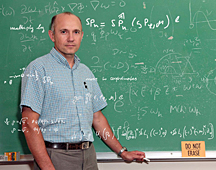- Number 315 |
- July 6, 2010
New PPPL Deputy Theory Head Gorelenkov likes making predictions

Nikolai Gorelenkov
Nikolai Gorelenkov is a theorist who appreciates the importance of experiments in advancing the fields of plasma physics and fusion energy research.
Experiments validate theories, which is why Gorelenkov, the new Deputy Head of the Theory and Computation Department at DOE’s Princeton Plasma Physics Laboratory (PPPL), believes working with experimentalists should be a priority for theorists.
“People who work in theory should not be fixed only on theoretical work; they should really reach out to the experimental programs,” said Gorelenkov, who has worked in theory since he joined PPPL’s staff in 1999.
Gorelenkov first came to PPPL as part of a U.S.-Russia exchange program in 1993, the same year he received a Ph.D. from the Kurchatov Institute in Moscow. He returned as part of the exchange program in 1995 and has been at the lab ever since.
Gorelenkov develops theory and models that help to predict the conditions of plasmas in which fusion occurs. Plasma is a hot, gaseous state of matter used as the fuel to produce fusion energy — the power source of the sun and other stars. When atomic nuclei gain enough energy in plasmas, they join to form a new atomic nucleus. When two deuterium (an isotope of hydrogen) nuclei fuse, one product is an alpha particle, which contains two protons and two neutrons. In burning plasmas, which haven’t yet been achieved in the laboratory, the rate of fusion is enough to produce many energetic alpha particles and energy to sustain the plasma itself. Understanding energetic particles’ behavior will be especially important for future fusion reactors.
Among his most significant work, Gorelenkov has helped to develop models that quantitatively predict how energetic particles are affected by plasma instabilities — changes in the motion of ions and electrons when they aren’t in equilibrium that can also cause changes in electromagnetic fields.
The instabilities can cause the energetic particles in a burning plasma to spread out and actually escape the magnetic field used to confine the plasma, reducing the efficiency of the reactor and potentially damaging the wall of a plasma chamber.
Gorelenkov worked on models that predicted the instabilities in ITER, the world’s first burning-plasma experiment set to begin later this decade. That work was essential to his earning the Kaul Prize for Excellence in Plasma Physics Research and Technology Development in 2007.
Gorelenkov said he is most proud of the predictive capabilities achieved by models of energetic particles. Theorists feel a special satisfaction when they see predictions confirmed by experiments, which gives credibility to their models.
“You can explain and predict things, and this is really what science is about,” Gorelenkov said. “To have such theory and simulations is exciting for the energetic-particle subfield in particular.”
Gorelenkov said his ultimate goal in theoretical plasma physics is to help create a comprehensive plasma modeling tool. Such a tool would allow physicists and engineers working on future fusion machines to predict the properties of plasmas.
Gorelenkov, who will be working closely with new Theory Department Head Riccardo Betti, anticipates helping to refocus some of the department’s research. For example, the interaction between plasma and its container wall is a critical area of research. Even though plasma must be contained using magnetic fields, it can heat and erode the physical wall beyond it and in turn be cooled by its surrounding wall. Researchers are still trying to determine the best wall composition for future fusion reactors.
While Gorelenkov enjoys being in control of his own research, he strongly supports collaborations with researchers around the world.
“There are established connections between institutions,” Gorelenkov said. “When important problems show up, people can contribute to these problems.”
Submitted by DOE's Princeton Plasma Physics Laboratory
